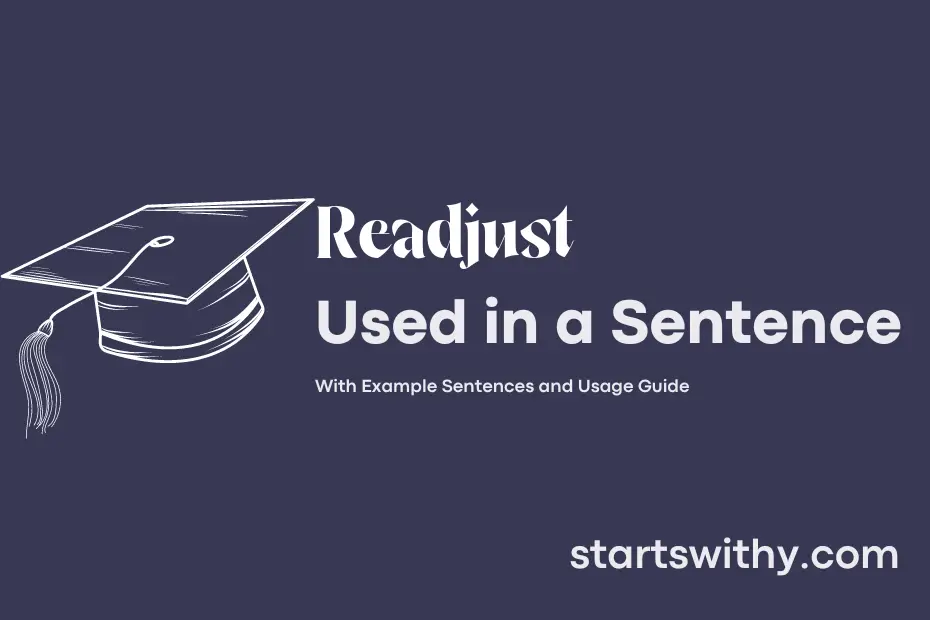Sometimes, life throws unexpected curveballs that may require us to readjust our plans or attitudes. In essence, to readjust means to make changes or modifications to something in order to better suit a new situation or circumstance.
Whether it’s a minor tweak to our daily routine or a major overhaul of our long-term goals, the ability to readjust is a valuable skill that can help us adapt and thrive in the face of challenges.
7 Examples Of Readjust Used In a Sentence For Kids
- Readjust your chair to make sure you are comfortable.
- Let’s readjust the puzzle pieces to finish the picture.
- Please readjust your bag so it doesn’t fall off your shoulder.
- Can you help me readjust the book on the shelf?
- It’s important to readjust your clothes if they feel too tight.
- Remember to readjust your mask if it keeps slipping.
- We should readjust the crayons in the box to keep them organized.
14 Sentences with Readjust Examples
- Make sure to readjust your study schedule to allocate more time for difficult subjects.
- You may need to readjust your budget to accommodate unexpected expenses during the semester.
- As the semester progresses, you might have to readjust your goals based on your current progress.
- Don’t hesitate to readjust your group study sessions if they are not productive.
- It’s important to readjust your sleeping pattern to ensure you are well-rested for classes.
- If you find that your study habits are not effective, it’s time to readjust your approach.
- Remember to readjust your course selection if you find that a subject is too challenging.
- It’s ok to readjust your extracurricular activities to manage your time better.
- Students often have to readjust their expectations regarding grades and performance.
- You may need to readjust your commute to save time and energy during the semester.
- It’s common to readjust your study environment to improve focus and concentration.
- After receiving feedback on your assignments, don’t forget to readjust your writing style accordingly.
- If you are feeling overwhelmed, take a step back and readjust your priorities.
- As the semester progresses, students often have to readjust their study habits to adapt to new challenges.
How To Use Readjust in Sentences?
To use Readjust in a sentence, follow these steps:
-
Identify the need: First, determine if you need to make an adjustment or change to something. This could be anything from a schedule, a plan, a setting, or an opinion.
-
Choose the appropriate moment: Find the right opportunity to bring up the adjustment in conversation or in writing. Make sure the timing is appropriate and considerate of others involved.
-
Formulate your sentence: When you are ready to use Readjust, construct your sentence with clarity and precision. Be specific about what is being adjusted and why.
-
Insert the word: Place the word Readjust appropriately in your sentence. For example, “I need to readjust my schedule to accommodate this new meeting.”
-
Ensure clarity: Make sure that the sentence conveys your intention accurately. Check if the use of Readjust fits in with the context of your sentence.
-
Practice makes perfect: Use Readjust in various sentences to become more comfortable with its usage. The more you practice, the more natural it will feel.
By following these steps, you can effectively use Readjust in a sentence. Remember to be clear, concise, and considerate when incorporating this word into your communication.
Conclusion
In conclusion, the concept of readjustment is crucial in various aspects of life. Whether it’s readjusting our schedules, goals, relationships, or expectations, the ability to adapt and modify our approach is essential for personal growth and success. By being open to readjusting our strategies and perspectives, we can navigate through challenges and setbacks more effectively, ultimately leading to better outcomes.
Embracing the process of readjustment allows us to be more resilient, flexible, and proactive in addressing changes and uncertainties. It empowers us to learn from experiences, make necessary tweaks, and continue moving forward with a renewed sense of purpose and determination. In essence, the practice of readjusting is a valuable skill that enables us to navigate life’s ups and downs with greater ease and adaptability.



